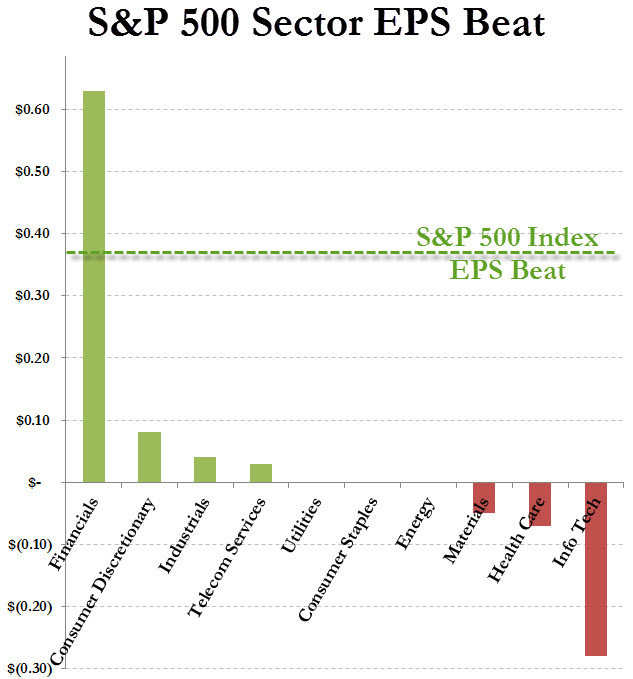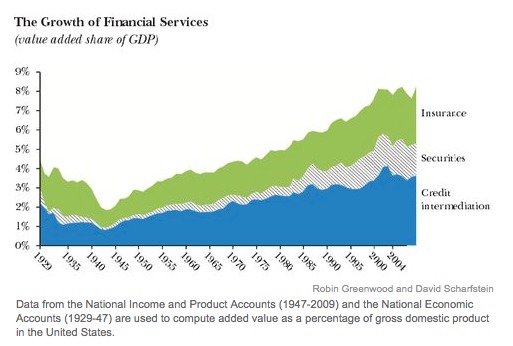As the fifth anniversary of the U.S. financial crisis draws near, Wall Street firms find themselves rolling in profits. U.S. financial companies are now ringing up the fastest earnings growth in the Standard & Poor’s 500 Index (SPX). Look at how the Financials trounced earnings estimates for the latest quarter:
On top of the surging earnings, financials are getting close to reclaiming their bragging rights as the stock market’s biggest industry by market capitalization. Alex Barinka and Whitney Kisling at Bloomberg note that:
Banks, brokers and insurance companies make up 16.8 percent of the S&P 500, almost double the level from 2009 and closing in on technology companies at 17.6 percent…The last time financial shares were the biggest group in the S&P 500 was May 2008, four months before Lehman Brothers Holdings Inc. filed the biggest bankruptcy in American history.
The market cap gains come from the strong stock performance – not surprising given the recent earnings gains:
Another sign of the Wall Street revival since the 2008 financial meltdown is bank asset size. Amazingly, despite the Dodd Frank reforms to prevent systemic financial risk, the U.S. banking system has become even more concentrated.
The top five banks–JPMorgan Chase & Co. (JPM), Bank of America Corp. (BAC), Citigroup (C), Wells Fargo (WFC), and Goldman Sachs (GS) — held $8.5 trillion in assets at the end of 2011, equal to 56% of the U.S. economy, according data by central bankers at the Federal Reserve. In 2006, the figure was 43%.
By one measure, using international standards for derivatives and consolidating mortgage securitizations, U.S. bank assets are roughly 170% the size of the entire $15 trillion American economy, according to Thomas Hoenig, vice chairman of the Federal Deposit Insurance Corp
So while the comeback of the high and mighty on Wall Street has been great news for stock investors in major banks, the living large U.S. financial sector may not be beneficial to the overall economy. Some economists believe that financialization—the outsized growth of the financial sector relative to overall gross domestic product—may be holding back the American economy.
Earlier this summer, Bruce Bartlett at the New York Times outlined the major academic research that casts an unflattering light on the over-sized U.S. financial sector.
Here are the major findings.
Income inequality: Consider research by Thomas Philippon of New York University and Ariell Reshef of the University of Virginia. Back in 1980, pay packages in the financial services industry was comparable to that in other industries until 1980. Now, employees in financial services make 70 percent more on average.
Distorted Investment: Ozgur Orhangazi of Roosevelt University has found that as financialization rises investment in the other parts of the economy falls. In addition, the fees for financial services paid by corporations “have reduced internal funds available for investment, shortened their planning horizon and increased uncertainty.”
Brain Drain: Bartlett also points out that that the financial sector leeches growth from other sectors is by attracting a rising share of the nation’s “best and brightest” workers, depriving other sectors like manufacturing of their skills.
There’s no denying that a vibrant financial sector is an essential element to economic competitiveness–and plenty of talented and dedicated professionals do great work at major financial institutions around the country. The issue is scale. Does America’s supersized financial sector present dangers that need to be addressed? That’s one issue that is still unresolved after the financial crisis.
Photo Credit: Alison Faith








